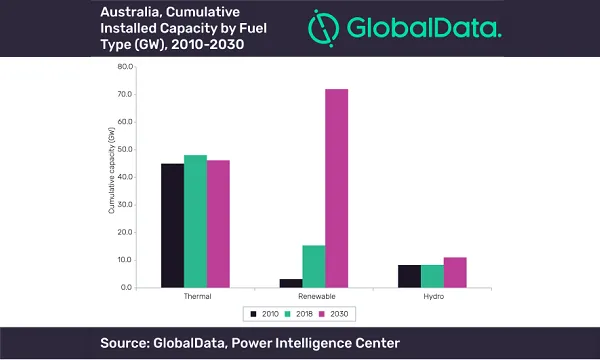
Renewables to eat up 55.7% of Australia's power mix by 2030
Battery-backed wind and solar farms are preferred by market stakeholders.
Renewables are expected to eat up 55.7% of Australia’s power capacity mix by 2030 thanks to acceleration brought about by battery-backed wind and solar farms, according to analytics firm GlobalData. “To meet the increasing demand of the power in the country and have an uninterrupted power supply, the stakeholders prefer battery-backed wind and solar farms,” it said.
The share of renewable energy in the country had reached 21.5% of the country’s power mix in 2018. Solar PV contributes the maximum amongst the non-hydro renewable energy sources with a share of 12.7%, followed by wind and bio power with a share 7.1% and 1.6% respectively. Besides, hydro power also holds a share of 11.6% in the same year.
The falling costs of renewable energy installations and introduction of strong policies to cut down pollution have led the policy makers focus more on renewable energy. The government has set a 20% renewable energy target by 2030 and the incentives attached to the target will drive significant investments.
Besides, high potential of clean energy sources, the country is expected to generate 43.5% of the electricity from renewable energy by 2030. National Energy Guarantee (NEG) is another promising opportunity to reduce emissions and ensure reliability in dispatchable energy supply.
However, thermal power continued to dominate Australia’s power mix with an overall share of 67%, with coal holding the maximum share of 36%.
Piyali Das, power industry analyst at GlobalData, commented, “Australia has an abundance of coal reserves, however; building a new coal-fired generating plant has become an expensive venture. Carbon risk, market price fluctuation and increasing environmental, social and governance exemplarity expectations have led the investors and debt providers demand a higher rate of returns. The government has also announced a lifetime limitation of 50 years for the coal-based power plants.”








![Cross Domain [Manu + SBR + ABF + ABR + FMCG + HBR + ]](https://cmg-qa.s3.ap-southeast-1.amazonaws.com/s3fs-public/styles/exclusive_featured_article/public/2025-01/earth-3537401_1920_4.jpg.webp?itok=WaRpTJwE)
![Cross Domain [SBR + ABR]](https://cmg-qa.s3.ap-southeast-1.amazonaws.com/s3fs-public/styles/exclusive_featured_article/public/2025-01/pexels-jahoo-867092-2_1.jpg.webp?itok=o7MUL1oO)









 Advertise
Advertise


